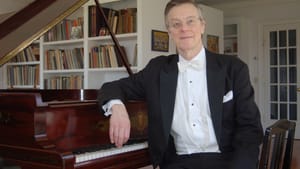Stay in the Loop
BSR publishes on a weekly schedule, with an email newsletter every Wednesday and Thursday morning. There’s no paywall, and subscribing is always free.
On the edge of musical revolt
Peter Serkin and the Orion Quartet

In this stunningly executed concert, two Haydn string quartets from the height of the classical period were set against two 20th-century compositions that ushered in the music of the modern repertoire. Both the continuity and contrast between Haydn’s music, tightly adhering to the diatonic scale and harmony, and the music of Max Reger and Arnold Schoenberg, which pushed composing into chromatic, intervallic, and serial forms, gave food for thought even as they conveyed riches of musical complexity and expressiveness.
The Haydn quartets provided a sturdy frame for Reger’s exploratory Piano Quartet and Schoenberg’s “Kammersymphonie,” originally composed for full chamber orchestra and later arranged by Anton Webern for string quartet and piano. The piano works capitalized on the formidable skills and interpretive capacity of pianist Peter Serkin, who has made it a point of advancing pieces from the modern repertoire that are less frequently performed, often because they are so technically and interpretively demanding that only he dares take them on.
Haydn performed with fervor
The two Haydn string quartets served as delightful breaks from the tensions inherent in Reger and Schoenberg. Although there were historical precursors, notably Allegri and Scarlatti, Haydn was the first composer to write extensively for the string quartet, and it is remarkable how well he mastered the idiom. He set out to balance the roles of cello and viola with the violins, creating a true ensemble feeling. He also balanced counterpoint and tutti passages, creating lush sonorities and an orchestral resonance. His quartets became the gold standard for Mozart and Beethoven, and they have held up remarkably well over time, sounding fresh and vital even today.
I loved the way the Orion Quartet rendered Haydn with energetic, romantic sonorities and dynamics rather than the cool, sleek style of some of the more youthful players. There was no question that the Orion players considered the Haydn masterworks worthy of the same attention as the Reger and Schoenberg. Their playing effectively countered the tendency to hear Haydn as a lightweight compared to those who followed him.
Music reflecting the 20th-century crisis
While fundamentally an expression of the romantic era, the Reger Piano Quartet in A Minor reflects the early 20th-century turn from diatonic to chromatic lines and shifting tonal centers, even bearing allusions to serial composition. Often romantically lyrical, it has an overall brooding and despairing quality, as if informed by Reger’s own imminent death and the beginning of World War I. It could easily have been cited by Leonard Bernstein in his famed Harvard Norton Lectures, in which he discussed the 20th-century crisis of the departure from diatonic syntax and key signature leading ultimately to serial composition — which Bernstein, rightly or wrongly, related to the crisis of faith and hope in western culture.
In this and other compositions, Reger instigates sudden shifts in tone, rhythm, and harmony, as if willing to abandon consistency in favor of the musical purpose of the moment. By taking such risks, he almost anticipated the sound palettes of later composers such as Samuel Barber and especially Benjamin Britten. There is a magnificence of scope, experimentation, and expression, but sadly, the piece doesn’t achieve the coherence and depth that makes for greatness, so it takes particularly daring musicians to dust it off and throw themselves into it.
Indeed, Serkin and the Orion Quartet plunged headlong into the music and gave a performance that brought out Reger’s remarkable, if somewhat choppy, excursions into the far reaches of musical possibility, while at the same time sustaining the composer’s late-romantic trajectory. Serkin performed even the most challenging piano passages with precision and an exacting adherence to tempo. Moreover, there is increased warmth to his playing that well complements his trademark modernist discipline. In this, he was supported by the rich sounds of the violin, viola, and cello. Together, they delivered the striving and searching inherent in Reger, elevating this work to high respect in the chamber repertoire.
Bringing out the best in Schoenberg
Arnold Schoenberg is arguably the most groundbreaking composer of the 20th century, developing serial composition into a disciplined approach that has influenced all music since then. His compositions have their own beauty and interest, but it must be somewhat like a hot potato to perform them, because they have a schizoid quality that leaves one straining to grasp what they are expressing on an emotional level. Schoenberg originally wrote Kammersymphonie for a full chamber ensemble, and he wisely assigned their orchestration for smaller groups to his students. A few years later, he chose Anton Webern to arrange the piece for piano quintet, and the latter gave it the sheen and electricity of a great attention-grabbing musical work.
The Kammersymphonie was composed before Schoenberg took the great leap into serial composition as such, and thus it is rich in deep, if struggling, melodically embodied emotional expressivity. Enormously complex in its harmonic variations and contrapuntal movement, it massively exemplifies the sheer genius of Schoenberg, the brilliance that drew budding composers like Berg and Webern to him in an almost idolatrous way. To perform this piece well, seasoned musicians must become students again and give detailed attention to its demanding complexity until they make it new and make it their own.
Serkin and the Orion musicians succeeded admirably in this effort. In their exceptional hands, the music unfolded in a rush of flow and expression, like a springtime river. With the help of Webern, these musicians revealed the potential for rendering Schoenberg not only as a brilliant genius, but also as expressing the deeper parts of himself. Such a performance casts his modernist legacy in a new light, illuminating how his innovations greatly enriched the expressive range of music in all its modern forms. He was not just playing with notes like a mathematician — he opened up whole new worlds of musical possibility for composers of all persuasions.
For Tom Purdom's review of this concert and another chamber performance of a symphonic transcription, click here.
What, When, Where
Philadelphia Chamber Music Society: Orion Quartet with Peter Serkin, Piano. Haydn: Quartet in C Major, Op. 50, No. 2; Reger: Piano Quartet in A Minor, Op. 133; Haydn: Quartet in F Major, Op. 77, No. 2; Schoenberg: Kammersymphonie, Op. 9 (Arr. by Webern). February 20, 2015 at Perelman Theater, Kimmel Center, Broad and Spruce Streets, Philadelphia. 215-569-8080 or www.pcmsconcerts.org.
Sign up for our newsletter
All of the week's new articles, all in one place. Sign up for the free weekly BSR newsletters, and don't miss a conversation.

 Victor L. Schermer
Victor L. Schermer